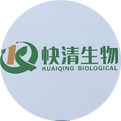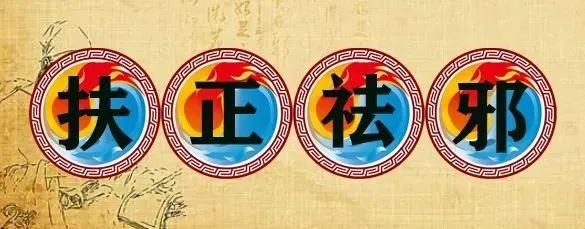
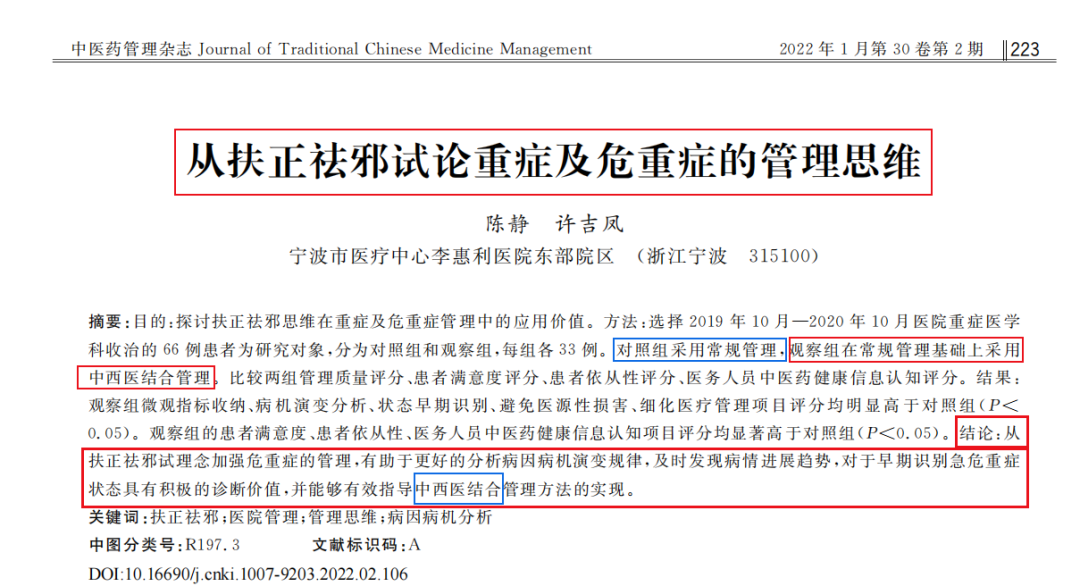 Abstract:Objective:To explore the application value of the “Support the Right and Eliminate the Evil” (Fu Zheng Qu Xie) concept in the management of severe and critical illnesses.Method:Sixty-six patients admitted to the Intensive Care Unit from October 2019 to October 2020 were selected as the study subjects, divided into a control group and an observation group, with 33 cases in each group.The control group received conventional management, while the observation group adopted a combination of traditional Chinese and Western medicine management based on conventional management.Quality assessment scores of management, patient satisfaction scores, patient compliance scores, and medical staff’s understanding of traditional Chinese medicine health information were compared between the two groups.Results:The observation group showed significantly higher scores in micro-indicators collection, pathogenesis evolution analysis, early identification of conditions, avoidance of iatrogenic harm, and refinement of treatment management compared to the control group (P < 0.05).The patient satisfaction, compliance, and medical staff’s understanding of traditional Chinese medicine health information scores in the observation group were also significantly higher than those in the control group (P < 0.05).Conclusion:Strengthening the management of critical illnesses through the “Support the Right and Eliminate the Evil” concept helps better analyze the evolution of pathogenesis, timely identify trends in disease progression, and has positive diagnostic value for early identification of critical conditions, effectively guiding the implementation of combined management methods of traditional Chinese and Western medicine.Keywords:Support the Right and Eliminate the Evil;Hospital Management;Management Thinking;Pathogenesis AnalysisClassification Number:R197.3 Document Identification Code:ATraditional Chinese Medicine (TCM) has a long history and has accumulated rich experience in the management of acute and critical patients. Through pathogenesis analysis, individual difference analysis, and the concept of prevention of disease, it has significant advantages in the management of clinical critical care medicine.In order to further optimize the management quality of clinical critical and severe patients, the department has recently incorporated the TCM concept of “Support the Right and Eliminate the Evil” into specialized management processes, achieving ideal management results.
Abstract:Objective:To explore the application value of the “Support the Right and Eliminate the Evil” (Fu Zheng Qu Xie) concept in the management of severe and critical illnesses.Method:Sixty-six patients admitted to the Intensive Care Unit from October 2019 to October 2020 were selected as the study subjects, divided into a control group and an observation group, with 33 cases in each group.The control group received conventional management, while the observation group adopted a combination of traditional Chinese and Western medicine management based on conventional management.Quality assessment scores of management, patient satisfaction scores, patient compliance scores, and medical staff’s understanding of traditional Chinese medicine health information were compared between the two groups.Results:The observation group showed significantly higher scores in micro-indicators collection, pathogenesis evolution analysis, early identification of conditions, avoidance of iatrogenic harm, and refinement of treatment management compared to the control group (P < 0.05).The patient satisfaction, compliance, and medical staff’s understanding of traditional Chinese medicine health information scores in the observation group were also significantly higher than those in the control group (P < 0.05).Conclusion:Strengthening the management of critical illnesses through the “Support the Right and Eliminate the Evil” concept helps better analyze the evolution of pathogenesis, timely identify trends in disease progression, and has positive diagnostic value for early identification of critical conditions, effectively guiding the implementation of combined management methods of traditional Chinese and Western medicine.Keywords:Support the Right and Eliminate the Evil;Hospital Management;Management Thinking;Pathogenesis AnalysisClassification Number:R197.3 Document Identification Code:ATraditional Chinese Medicine (TCM) has a long history and has accumulated rich experience in the management of acute and critical patients. Through pathogenesis analysis, individual difference analysis, and the concept of prevention of disease, it has significant advantages in the management of clinical critical care medicine.In order to further optimize the management quality of clinical critical and severe patients, the department has recently incorporated the TCM concept of “Support the Right and Eliminate the Evil” into specialized management processes, achieving ideal management results.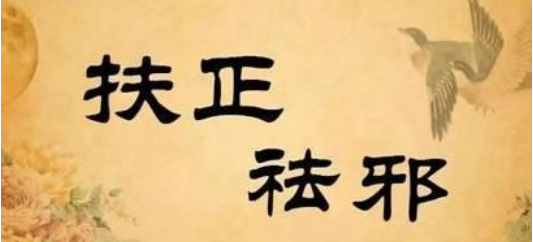 1. Data and Methods1.1 General DataSixty-six patients admitted to the Intensive Care Unit from October 2019 to October 2020 were selected as the study subjects, divided into a control group and an observation group, with 33 cases in each group. In the control group, there were 20 males and 13 females; ages ranged from 37 to 73 years. In the observation group, there were 21 males and 12 females; ages ranged from 36 to 75 years. There were no significant differences in general data between the two groups (P > 0.05), indicating comparability.1.2 MethodsThe control group adopted a conventional management process for severe diseases. After understanding the condition and treatment, monitoring was performed, with timely checks on patients and recording of changes in conditions, reporting potential risk factors promptly. At the same time, it ensured that medical equipment was in good condition and tracked important laboratory results in a timely manner. The observation group, based on conventional management, adopted TCM management concepts, exploring the pathogenesis evolution and management strategies of severe diseases from the perspectives of supporting the right, eliminating the evil, and addressing Qi, body fluids, blood, and spirit:① Qi counterflow and fluid damage: Acute and critical patients often present with chaotic rising and falling, and if not corrected in time, can lead to life-threatening phenomena such as “rising and falling cessation” and “entry and exit failure.” For patients with severe clinical symptoms, it indicates that the righteous Qi is still sufficient to resist the evil, which can easily affect organ function, leading to fluid damage and Qi counterflow. At this time, appropriate medical measures should be taken to prevent Qi counterflow and avoid further disease progression.② Fluid depletion and blood movement: For patients who gradually lose weight, have sunken eye sockets, and loose skin, there is a change in blood, and phlegm and stasis can flow with the blood, worsening the condition. TCM supportive and nourishing herbs should be used, combined with appropriate nutritional support management.③ Damage to essence and disturbance of spirit: For patients who lose consciousness, it indicates that the disease progression has led to damage to the essence, disturbing the spirit. Comprehensive management methods such as protecting the original Qi should be implemented.1.3 Management Quality EvaluationBased on the management process in critical care medicine, management quality evaluation indicators and methods were established. Micro-indicators collection, pathogenesis evolution analysis, early identification of conditions, avoidance of iatrogenic harm, and refinement of treatment management were set as management quality evaluation indicators, and the scores of management quality between the two groups were compared (full score of 10 points). Patient satisfaction, compliance, and medical staff’s understanding of TCM health information evaluation methods were also set (full score of 10 points) and compared between groups. Statistical analysis was performed using t-tests for comparisons between the two groups.2. Results2.1 Comparison of Management-Related Project Scores Between the Two GroupsThe observation group had significantly higher scores in micro-indicators collection, pathogenesis evolution analysis, early identification of conditions, avoidance of iatrogenic harm, and refinement of treatment management compared to the control group (P < 0.05). See Table 1.
1. Data and Methods1.1 General DataSixty-six patients admitted to the Intensive Care Unit from October 2019 to October 2020 were selected as the study subjects, divided into a control group and an observation group, with 33 cases in each group. In the control group, there were 20 males and 13 females; ages ranged from 37 to 73 years. In the observation group, there were 21 males and 12 females; ages ranged from 36 to 75 years. There were no significant differences in general data between the two groups (P > 0.05), indicating comparability.1.2 MethodsThe control group adopted a conventional management process for severe diseases. After understanding the condition and treatment, monitoring was performed, with timely checks on patients and recording of changes in conditions, reporting potential risk factors promptly. At the same time, it ensured that medical equipment was in good condition and tracked important laboratory results in a timely manner. The observation group, based on conventional management, adopted TCM management concepts, exploring the pathogenesis evolution and management strategies of severe diseases from the perspectives of supporting the right, eliminating the evil, and addressing Qi, body fluids, blood, and spirit:① Qi counterflow and fluid damage: Acute and critical patients often present with chaotic rising and falling, and if not corrected in time, can lead to life-threatening phenomena such as “rising and falling cessation” and “entry and exit failure.” For patients with severe clinical symptoms, it indicates that the righteous Qi is still sufficient to resist the evil, which can easily affect organ function, leading to fluid damage and Qi counterflow. At this time, appropriate medical measures should be taken to prevent Qi counterflow and avoid further disease progression.② Fluid depletion and blood movement: For patients who gradually lose weight, have sunken eye sockets, and loose skin, there is a change in blood, and phlegm and stasis can flow with the blood, worsening the condition. TCM supportive and nourishing herbs should be used, combined with appropriate nutritional support management.③ Damage to essence and disturbance of spirit: For patients who lose consciousness, it indicates that the disease progression has led to damage to the essence, disturbing the spirit. Comprehensive management methods such as protecting the original Qi should be implemented.1.3 Management Quality EvaluationBased on the management process in critical care medicine, management quality evaluation indicators and methods were established. Micro-indicators collection, pathogenesis evolution analysis, early identification of conditions, avoidance of iatrogenic harm, and refinement of treatment management were set as management quality evaluation indicators, and the scores of management quality between the two groups were compared (full score of 10 points). Patient satisfaction, compliance, and medical staff’s understanding of TCM health information evaluation methods were also set (full score of 10 points) and compared between groups. Statistical analysis was performed using t-tests for comparisons between the two groups.2. Results2.1 Comparison of Management-Related Project Scores Between the Two GroupsThe observation group had significantly higher scores in micro-indicators collection, pathogenesis evolution analysis, early identification of conditions, avoidance of iatrogenic harm, and refinement of treatment management compared to the control group (P < 0.05). See Table 1. 2.2 Comparison of Other Project Evaluations Between the Two GroupsThe observation group had significantly higher scores in patient satisfaction, compliance, and medical staff’s understanding of TCM health information compared to the control group (P < 0.05). See Table 2.
2.2 Comparison of Other Project Evaluations Between the Two GroupsThe observation group had significantly higher scores in patient satisfaction, compliance, and medical staff’s understanding of TCM health information compared to the control group (P < 0.05). See Table 2.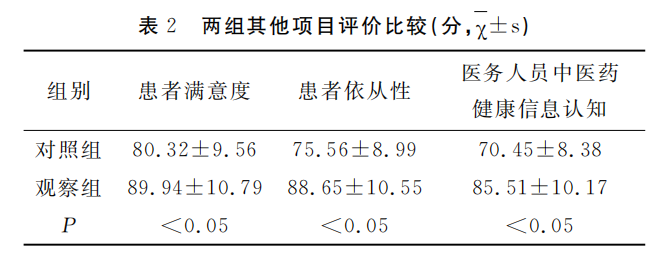 3. DiscussionTCM has provided a comprehensive overview of human life activities. The “Lingshu: Ben Zang” states, “The blood, Qi, and spirit of a person are what sustain life and circulate through the body.” The “Huangdi Neijing” also discusses the basic substances of life, believing that the essence, Qi, blood, body fluids, and pulse combine to form the body. Acute patients often present with sudden onset, typically showing imbalances of Yin and Yang, Qi counterflow, and further depletion of fluids and blood. Management should be conducted from the perspective of supporting the right and eliminating the evil, suppressing disease progression and promoting recovery.Numerous studies have shown that analyzing the distribution patterns of TCM syndromes can effectively guide the management methods for critical patients, improving prognosis. In managing critical patients, the application of TCM nutrition can provide a comprehensive assessment of the patient’s nutritional status and improve it through TCM methods, thereby enhancing the patient’s immune function and actively assisting clinical specialized management.In this study, the department incorporated TCM management thinking and concepts into the management process of critical and severe patients, exploring the pathogenesis evolution and management strategies of severe diseases from the perspectives of supporting the right and eliminating the evil, and addressing Qi, body fluids, blood, and spirit. TCM syndrome differentiation concepts suggest that critical patients exhibit characteristics such as Qi counterflow, fluid depletion, and damage to essence and disturbance of spirit, thus requiring targeted TCM interventions.Acute and critical patients often present with chaotic rising and falling, and if not corrected in time, can lead to life-threatening phenomena such as “rising and falling cessation” and “entry and exit failure.” Therefore, for patients with severe clinical symptoms, appropriate medical measures should be taken to prevent Qi counterflow and avoid further disease progression. For patients showing gradual weight loss, sunken eye sockets, and loose skin, TCM supportive and nourishing management should be adopted, along with appropriate nutritional support.For patients who lose consciousness, methods to protect the original Qi should be employed. The results of this study show that the observation group had significantly higher scores in micro-indicators collection, pathogenesis evolution analysis, early identification of conditions, avoidance of iatrogenic harm, and refinement of treatment management compared to the control group (P < 0.05), confirming the advantages and value of TCM management thinking in severe diseases.Further analysis revealed that the observation group had significantly higher scores in patient satisfaction, compliance, and medical staff’s understanding of TCM health information compared to the control group (P < 0.05).In summary, analyzing the impact of Qi, blood, body fluids, and spirit on the progression of severe diseases from the perspective of supporting the right and eliminating the evil can integrate modern medical micro-indicators, better analyze the evolution of pathogenesis, and timely identify trends in disease progression, providing positive diagnostic value for early identification of critical conditions and effectively guiding the implementation of combined management methods of traditional Chinese and Western medicine. The TCM management concept utilizes a combination of various methods, achieving a comprehensive and systematic implementation of the management path of supporting the right and eliminating the evil, refining treatment management plans, and optimizing management processes. Patients’ satisfaction and compliance with the combined management of traditional Chinese and Western medicine were high, and medical staff were able to enhance their TCM-related knowledge and broaden their management perspectives through the application of TCM-related management knowledge.
3. DiscussionTCM has provided a comprehensive overview of human life activities. The “Lingshu: Ben Zang” states, “The blood, Qi, and spirit of a person are what sustain life and circulate through the body.” The “Huangdi Neijing” also discusses the basic substances of life, believing that the essence, Qi, blood, body fluids, and pulse combine to form the body. Acute patients often present with sudden onset, typically showing imbalances of Yin and Yang, Qi counterflow, and further depletion of fluids and blood. Management should be conducted from the perspective of supporting the right and eliminating the evil, suppressing disease progression and promoting recovery.Numerous studies have shown that analyzing the distribution patterns of TCM syndromes can effectively guide the management methods for critical patients, improving prognosis. In managing critical patients, the application of TCM nutrition can provide a comprehensive assessment of the patient’s nutritional status and improve it through TCM methods, thereby enhancing the patient’s immune function and actively assisting clinical specialized management.In this study, the department incorporated TCM management thinking and concepts into the management process of critical and severe patients, exploring the pathogenesis evolution and management strategies of severe diseases from the perspectives of supporting the right and eliminating the evil, and addressing Qi, body fluids, blood, and spirit. TCM syndrome differentiation concepts suggest that critical patients exhibit characteristics such as Qi counterflow, fluid depletion, and damage to essence and disturbance of spirit, thus requiring targeted TCM interventions.Acute and critical patients often present with chaotic rising and falling, and if not corrected in time, can lead to life-threatening phenomena such as “rising and falling cessation” and “entry and exit failure.” Therefore, for patients with severe clinical symptoms, appropriate medical measures should be taken to prevent Qi counterflow and avoid further disease progression. For patients showing gradual weight loss, sunken eye sockets, and loose skin, TCM supportive and nourishing management should be adopted, along with appropriate nutritional support.For patients who lose consciousness, methods to protect the original Qi should be employed. The results of this study show that the observation group had significantly higher scores in micro-indicators collection, pathogenesis evolution analysis, early identification of conditions, avoidance of iatrogenic harm, and refinement of treatment management compared to the control group (P < 0.05), confirming the advantages and value of TCM management thinking in severe diseases.Further analysis revealed that the observation group had significantly higher scores in patient satisfaction, compliance, and medical staff’s understanding of TCM health information compared to the control group (P < 0.05).In summary, analyzing the impact of Qi, blood, body fluids, and spirit on the progression of severe diseases from the perspective of supporting the right and eliminating the evil can integrate modern medical micro-indicators, better analyze the evolution of pathogenesis, and timely identify trends in disease progression, providing positive diagnostic value for early identification of critical conditions and effectively guiding the implementation of combined management methods of traditional Chinese and Western medicine. The TCM management concept utilizes a combination of various methods, achieving a comprehensive and systematic implementation of the management path of supporting the right and eliminating the evil, refining treatment management plans, and optimizing management processes. Patients’ satisfaction and compliance with the combined management of traditional Chinese and Western medicine were high, and medical staff were able to enhance their TCM-related knowledge and broaden their management perspectives through the application of TCM-related management knowledge. References[1]Chen Tengfei, Liu Qingquan. Exploring the Pathogenesis Evolution of Acute and Critical Illnesses from the Perspectives of Qi, Body Fluids, Blood, and Spirit. [J]. Chinese Journal of TCM Emergency, 2018, 27(2): 303-305.[2]Chen Haisheng. On the Principles and Connotations of the “Support the Right and Eliminate the Evil” Method—Reflections on Reading the “Shanghan Lun”. [J]. Guangming TCM, 2014, 29(11): 2376-2377.[3]Zhang Keqing, Wang Jinzhou, Li Hailiang, et al. The Impact of Combined Management of Traditional Chinese and Western Medicine on Cardiac Function and Quality of Life in Patients with Chronic Heart Failure. [J]. Guangming TCM, 2020, 35(6): 898-901.[4]Pan Feng. Effective Management of Acute Heart Failure through Combined Traditional Chinese and Western Medicine—An Interview with Professor Wang Xiaolong from Shanghai University of Traditional Chinese Medicine. [J]. Chinese Medical Guide, 2020, 17(4): 1-3.[5]Wen Liangshuang. Analysis of the Effects of the “Preventive Treatment of Disease” Health Management Model in High-Risk Groups for Stroke through Combined Traditional Chinese and Western Medicine. [J]. Chinese Health Nutrition, 2020, 30(24): 368.[6]Zheng Yongqiang, Pan Yanmei, Xue Yinrong. Observational Study on the Intervention Effects of Combined Traditional Chinese and Western Medicine Management Model under Internet Plus Thinking for Type 2 Diabetes. [J]. Jiangxi TCM, 2020, 51(8): 41-43.(Received Date: 2021-05-20)
References[1]Chen Tengfei, Liu Qingquan. Exploring the Pathogenesis Evolution of Acute and Critical Illnesses from the Perspectives of Qi, Body Fluids, Blood, and Spirit. [J]. Chinese Journal of TCM Emergency, 2018, 27(2): 303-305.[2]Chen Haisheng. On the Principles and Connotations of the “Support the Right and Eliminate the Evil” Method—Reflections on Reading the “Shanghan Lun”. [J]. Guangming TCM, 2014, 29(11): 2376-2377.[3]Zhang Keqing, Wang Jinzhou, Li Hailiang, et al. The Impact of Combined Management of Traditional Chinese and Western Medicine on Cardiac Function and Quality of Life in Patients with Chronic Heart Failure. [J]. Guangming TCM, 2020, 35(6): 898-901.[4]Pan Feng. Effective Management of Acute Heart Failure through Combined Traditional Chinese and Western Medicine—An Interview with Professor Wang Xiaolong from Shanghai University of Traditional Chinese Medicine. [J]. Chinese Medical Guide, 2020, 17(4): 1-3.[5]Wen Liangshuang. Analysis of the Effects of the “Preventive Treatment of Disease” Health Management Model in High-Risk Groups for Stroke through Combined Traditional Chinese and Western Medicine. [J]. Chinese Health Nutrition, 2020, 30(24): 368.[6]Zheng Yongqiang, Pan Yanmei, Xue Yinrong. Observational Study on the Intervention Effects of Combined Traditional Chinese and Western Medicine Management Model under Internet Plus Thinking for Type 2 Diabetes. [J]. Jiangxi TCM, 2020, 51(8): 41-43.(Received Date: 2021-05-20)
